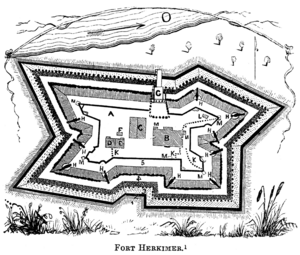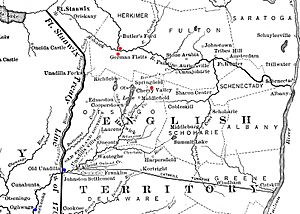Attack on German Flatts (1778) facts for kids
Quick facts for kids Attack on German Flatts |
|||||||
|---|---|---|---|---|---|---|---|
| Part of the American Revolutionary War | |||||||
 Fort Herkimer, drawing probably by Benson Lossing |
|||||||
|
|||||||
| Belligerents | |||||||
Iroquois |
|||||||
| Commanders and leaders | |||||||
| Peter Bellinger | Joseph Brant William Caldwell |
||||||
| Strength | |||||||
| Tryon County militia | 152 Iroquois 200–300 Loyalists |
||||||
| Casualties and losses | |||||||
| 3 killed 719 homeless |
not reported | ||||||
The Attack on German Flatts happened on September 17, 1778, during the American Revolutionary War. It was a surprise attack on a small settlement called German Flatts in New York. Today, this area includes what is now Herkimer.
The attack was carried out by a group of Loyalists and Iroquois warriors. Loyalists were American colonists who stayed loyal to the British king. The Iroquois were Native American nations, some of whom allied with the British. Their leader was a Mohawk chief named Joseph Brant. The raid destroyed many homes, barns, and crops. The attackers also took livestock like horses and cattle.
Luckily, the settlers were warned by a brave runner named Adam Helmer. This warning gave them time to hide in nearby forts. Because of this, very few people were killed, but many lost their homes. This attack was part of a series of raids on frontier settlements in New York and Pennsylvania.
Contents
Why Did This Attack Happen?
After the Battle of Saratoga in October 1777, the war in upstate New York changed. It became a "frontier war." This means it was fought on the edge of settled lands, often involving quick raids. British leaders in Canada supported Loyalists and Native American fighters. They gave them supplies and weapons.
During the winter of 1777–78, Joseph Brant and other Native American allies of the British planned attacks. They wanted to raid American settlements in New York and Pennsylvania. Brant set up a base at Onaquaga (which is now Windsor, New York). He gathered about 200 to 300 Iroquois and Loyalists. One of his goals was to get food and supplies for his fighters. He also raided other communities throughout the summer.
In July, Brant raided settlements at Springfield and Andrustown. He warned the survivors that German Flatts would be next. The German Flatts settlement was founded in 1723 by German immigrants. It was defended by a local group of citizen soldiers called the militia. Colonel Peter Bellinger led this militia. There were two main forts nearby: Fort Dayton and Fort Herkimer. They were on opposite sides of the Mohawk River.
Getting Ready for the Attack
Brant had planned to attack German Flatts earlier. However, he waited for another British-allied leader, John Butler. Butler had been involved in an attack on the Wyoming Valley. He sent Captain William Caldwell to recruit more men.
By early September, Butler was not coming back. So, Brant and Caldwell decided to launch the attack with the men they had. Their force included about 152 Mohawk and other Iroquois warriors. They also had between 200 and 300 Loyalists.

Colonel Bellinger had heard warnings about Brant's plans. He sent out scouts to gather information. On September 16, Brant's group surprised a scouting party of nine men. Some were killed, and the rest scattered. One survivor was Adam Helmer. He ran about 26 miles (42 km) to warn German Flatts. Colonel Bellinger quickly called his militia to action. He also asked for help from another colonel, Jacob Klock. The settlers rushed to hide inside the forts.
The Attack on German Flatts
Caldwell, Brant, and their men arrived at German Flatts on the evening of September 16. They began their attack the next morning. Because the settlers were safe inside the forts, the attackers could not capture many people. They showed themselves outside the forts, but they didn't have big cannons to attack the strong walls.
Instead, they went through the communities on both sides of the Mohawk River. They destroyed 63 homes and many barns. They also burned three grist mills (for grinding grain) and one saw mill. They took a large number of horses, cattle, and sheep. Any animals they couldn't take, they killed. The only buildings left standing were the forts, one barn, the church, and the homes of the minister and a few Loyalists.
More than 700 people lost their homes because of the destruction. Thanks to Adam Helmer's warning, only three Americans were killed. Captain Caldwell later wrote that his men "would have in all probability killed most of the inhabitants of German Flatts had they not been apprised of our coming by one of the scouts getting in and warning of our approach, and perhaps got to their forts."
What Happened Next?
Colonel Klock's militia arrived after the attackers had already left. The American militia chased after the raiders but couldn't catch them. However, some friendly Oneidas and Tuscaroras took advantage of Brant's absence. They raided Unadilla, a town where Brant had been. They freed prisoners Brant had taken on his way to German Flatts.
In early October, the Americans launched their own attacks. They destroyed Unadilla and Onaquaga. Brant and John Butler's son, Walter, then planned another attack. This led to a terrible event known as the Cherry Valley massacre in November.
These attacks by Brant and Butler led the Continental Congress to plan a major army expedition. This expedition, led by Generals John Sullivan and James Clinton, happened in 1779. It systematically destroyed the villages of Iroquois tribes who fought for the British. However, it didn't completely stop the frontier war. The German Flatts area continued to be attacked many times.
The 1936 novel Drums Along the Mohawk by Walter D. Edmonds tells the story of Adam Helmer's run. It also gives a good picture of the German settlements along the Mohawk River. The book was made into a movie in 1939, directed by John Ford.


